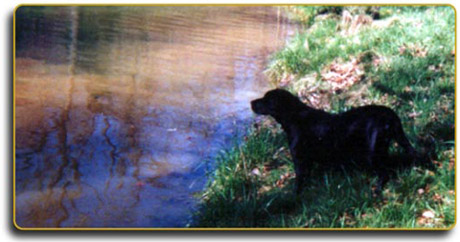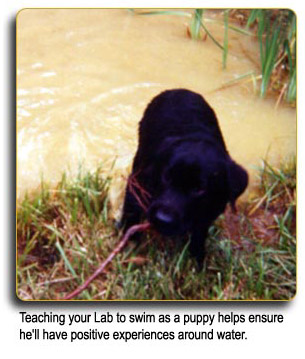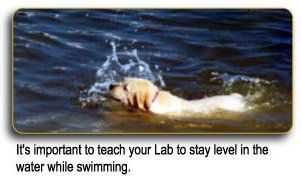


Christmas Store
The holidays are just around the corner so now is the time to fetch the finest gifts for the Labrador Lover on your Christmas list. We have over 100 gifts $50.00 and under. Visit our Christmas Store.
For the Lab
Bedding
Coats
Collars and Leads
Dog Bowls
Feeding Stations
Spa and Grooming
Toys and Treats
Travel and Accessories
For the Lab Lover
Apparel
Cards and Giftwrap
Fine Accessories
Gifts and All Occasions
Jewelry
Kids Only
For the Lab Home
Artwork
Books
Garden and Outdoor
Home Furnishings
Kitchen Accessories
Pillows, Throws, and Rugs
Gift ServicesGift Boxes
Gift Certificates
Teaching Your Lab to Swim Means Summers of Fun

There are few breeds of dog more famous for their love of the water than the Labrador Retriever. We’ve all seen a Lab (or a pack of Labs) frolic in the water for hours on end, and most of us who have owned Labs have had to drag them forcibly away from the shoreline toward home! However, as unlikely as it may seem, Labs do not come “out of the box” knowing how to swim. Furthermore, some Labs become truly nervous around water. That having been said, most Labs can be taught to swim quickly and easily, and a few simple lessons can lead to hours of enjoyment for both you and your dog. Here’s a few thoughts on getting started on the right paw.
A Sure Bet for Failure – “Sink or Swim”
There is no method of teaching your Lab to swim more likely to fail than throwing him in the water. Whether done from shore where it’s shallow, or (even worse) from a boat, forcing your dog into the water is almost certain to cause the instant development of aversion to water in your dog’s mind. Even more serious, pushing your Lab off a boat where he can’t stand on the bottom puts him at serious risk of drowning. Positive, safe training methods are the only option for teaching your Lab to swim. Never force your dog into the water.
Start Young
There are a number of reasons to teach your Lab to swim while he’s still a pup. For one thing, it’s easier on the dog. A large dog has a lot of body weight to manage in the water, and for a dog new to swimming, this can increase the slope of the learning curve. Puppies, because of their small size, have an easier time.

Teaching your Lab to swim while he’s still a pup is easier on you, too. With a puppy, you’ll be able to do all your training while only getting your hands and lower legs wet! With an adult dog, you’ll have to get deeper in the water and will most likely end up soaked from the dog’s initial attempts to doggy-paddle. There’s also a safety concern worth noting when working with a very large dog. When a dog panics, he may try to plant his back feet on the bottom and his front feet on you. A large dog can knock you over when he does this, and if he ends up on top of you in doing so, there is a risk of him holding you under the surface.
Probably the most convincing argument for starting young, however, is that your Lab is less likely to have any serious fears of the water! There is no reason for a dog to fear water when he has never had any experience with it. By teaching your dog to swim while he’s still young, you can ensure that his first encounters with water are positive. In fact, starting young decreases the likelihood that you’ll have to teach your Lab anything at all! One short, positive session may be all your Lab needs to take off swimming. However, for those dogs with more trepidation, starting young will ensure that a little nervousness doesn’t turn into a real fear.
So what’s the perfect age to start? Two to five months. At this age, your Lab is old enough to be able to manage his body in the water, has developed the immune system to protect him from being wet, and is still small enough that you can handle him easily.
Build Confidence Around Water
Even before you teach your Lab to swim, you can start off on the right foot by building his confidence around water. Take your dog for a walk around the local pond or lake. Encourage any interest that your dog shows in the water with verbal praise. If he is willing to get his feet wet, encourage him to do so and praise him when he does. Simple preliminaries like this lay a strong foundation for you because you teach the dog that there is no reason to fear water.
Remember that the primary goal here is to provide positive experiences for your Lab around and in the water. Making sure that the aquatic site you've chosen is safe goes a long way towards ensuring such experiences. Always check the shoreline and the water itself for hazards before allowing your dog into the water. This includes looking for submerged logs or other hazards that might injure your dog when he jumps in. Also be on the lookout for old fishing tackle, rusty metal, and so on. You should also be aware of the water quality at the site you've chosen. Letting your Lab swim in foul or polluted water is a good recipe for a sick dog!
Lesson One

To begin teaching your Lab to swim, take your pup to a calm lake or pond on a warm day. Bring a helper with you, and wear shorts, a swim suit, or waders. Leave your helper on shore, and carry your puppy out about ten or fifteen feet into the water – no deeper than your knees. Hold your pup by placing one hand under his belly and chest, and use the other hand to hold his back end level with his front (you can do this by gently holding the base of his tail). Lower your puppy into the water, but don’t let go yet.
Instinctively, your Lab will start paddling. Encourage him! Use positive verbal reinforcement to praise your pup. Treats and toys are a bad idea as they distract the puppy from the job at hand, but there’s nothing wrong with verbal praise! Once your pup is paddling strongly, remove your hand from under his belly for a few seconds, but continue to hold his back end level with the front.
Keeping your dog level during the first few swimming lessons is important. Most dogs that have trouble swimming let their back ends sink. Once the dog is vertical in the water, it’s very hard for him to make forward progress.
Once you feel comfortable that your pup can stay level and afloat, have your handler attract the dog from shore. Exciting body language, clapping, and verbal enticement are key here. When your pup is paddling strongly, release him completely and let him swim to your helper ashore. When he makes it, praise him generously. Be ready to scoop him up if it looks like he’s having trouble. If he does have trouble, decrease the distance between you and your helper and try again. That’s all there is to it! After several repetitions, pack up and go home. Repeat the training session daily, increasing the distance your Lab has to swim as he becomes comfortable with the exercise.
Once your Lab is comfortable swimming from you to the shoreline, you can begin to encourage him to swim out away from the shore on his own. With Labs, the easiest way to do this is to take advantage of the dog’s inherent retrieve drive. Away from the water, develop the go-fetch game with your dog, using a toy that you know will float. Once your Lab has learned to retrieve this toy on land, take him to the water. Throw the toy a short (10 feet) distance from the shore, and encourage your Lab as he swims out to retrieve it. If the bottom of the pond slopes gradually and your dog doesn’t get his feet off the bottom, don’t worry – the idea is simply to encourage the dog to go out into the water without you. When he returns his toy to you, praise him heavily. As the dog becomes comfortable with this exercise, you can gradually increase the distance you throw the toy. In no time, your Lab will be swimming like a champ!
Older Dogs
What if your Lab is already an adult, and you can’t start young? You can use the very same techniques to teach your adult Lab to swim. Keep in mind that you may need two helpers – one on shore, and a second to help you hold the dog in the water. Also realize that you’ll have to go deeper to get your dog’s feet off the bottom. If you’re not comfortable in water deeper than your knees, find somebody who is. Remember that the trick when starting out is to ensure that your dog stays level in the water.

Dogs and Boats
Never take a dog who doesn’t know how to swim in a boat of any kind. However, Labs who are experienced swimmers can have a lot of fun aboard boats – and they make great company as well. Keep safety in mind when you bring a dog aboard. Your Lab should wear both a canine life jacket and identification when on board. Don’t let your dog romp about the boat while you’re underway, either. Make him sit or lie down. Don’t crate your dog aboard a boat; in the event of an accident, he will drown as the kennel sinks.
Introduce your Lab to the boat while it’s still at dock. Encourage your dog to explore the boat, and to board the boat from the dock. Once he is comfortable, take him on a short trip away from shore, watching him carefully to make sure he doesn’t try to jump overboard. As always, increase the length of your trips gradually, as the dog becomes comfortable with the new vehicle.
Don’t Force the Issue
For most Labs, there are no better times to be had than those had around (and in) the water. However, there are those Labs who harbor a true fear of the water. There’s seldom a compelling reason to force such a dog to learn to swim. Your dog is no less a Lab just because he can’t swim, and he’ll make just as good a companion dry as he will wet. Swimming is supposed to be a fun activity for people and dogs; if your dog can’t see the fun in it, simply find another game!
As for the rest of the Labs out there – those for whom wetter is better – enjoy the summer!
 Can You Spot The Holiday Hazards?
Can You Spot The Holiday Hazards?It’s easy for pets, especially Labradors, to get into trouble during the holidays. You may get so busy that you lose track of what is going on with your dog.
Click here to learn more about: "Can You Spot The Holiday Hazards?"

Would you like to see your Lab pictured here? Send us images of your Lab and we may include them on our Home Page!
Labrador Links
The Verstaile Lab
History of the Lab
Advice
Travel
Featured Labs
Featured Artists
.jpg)

